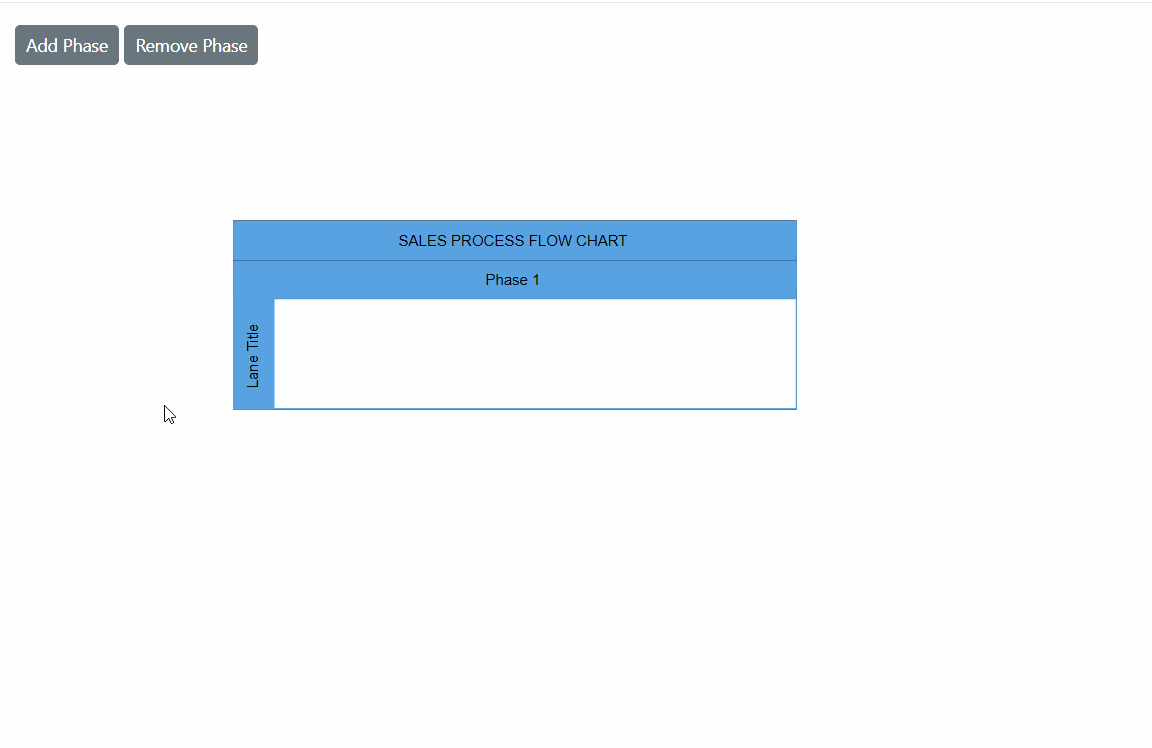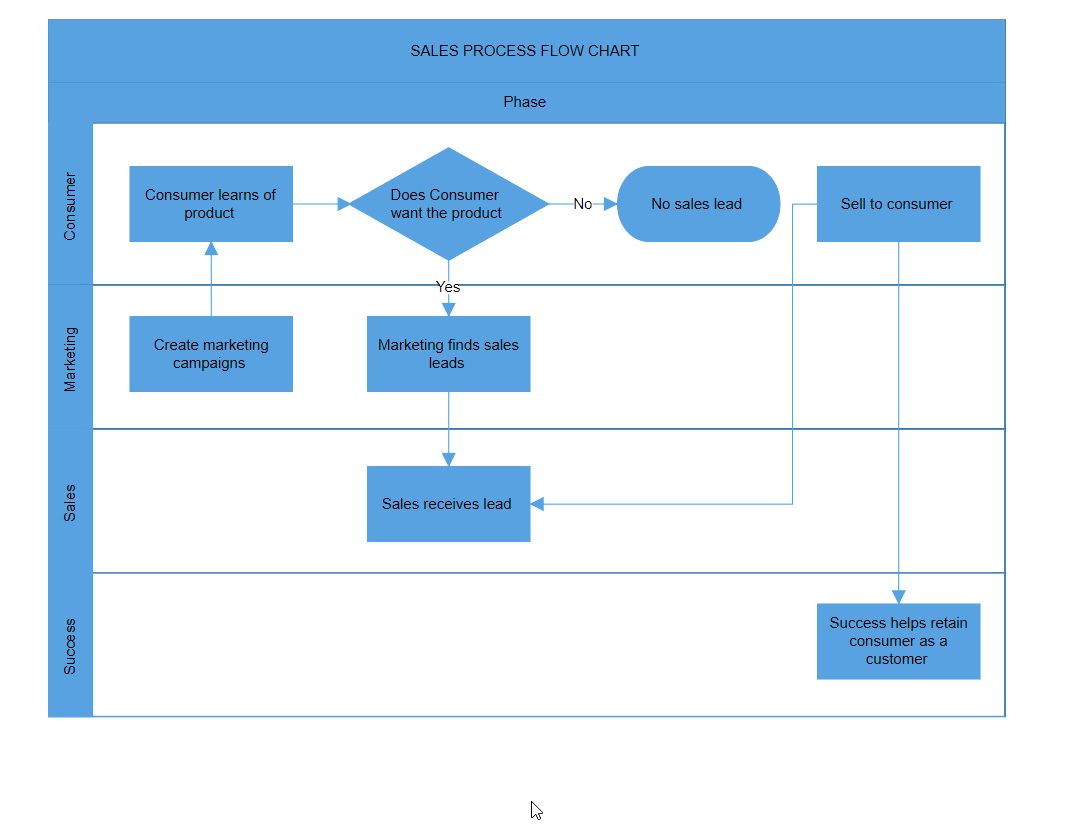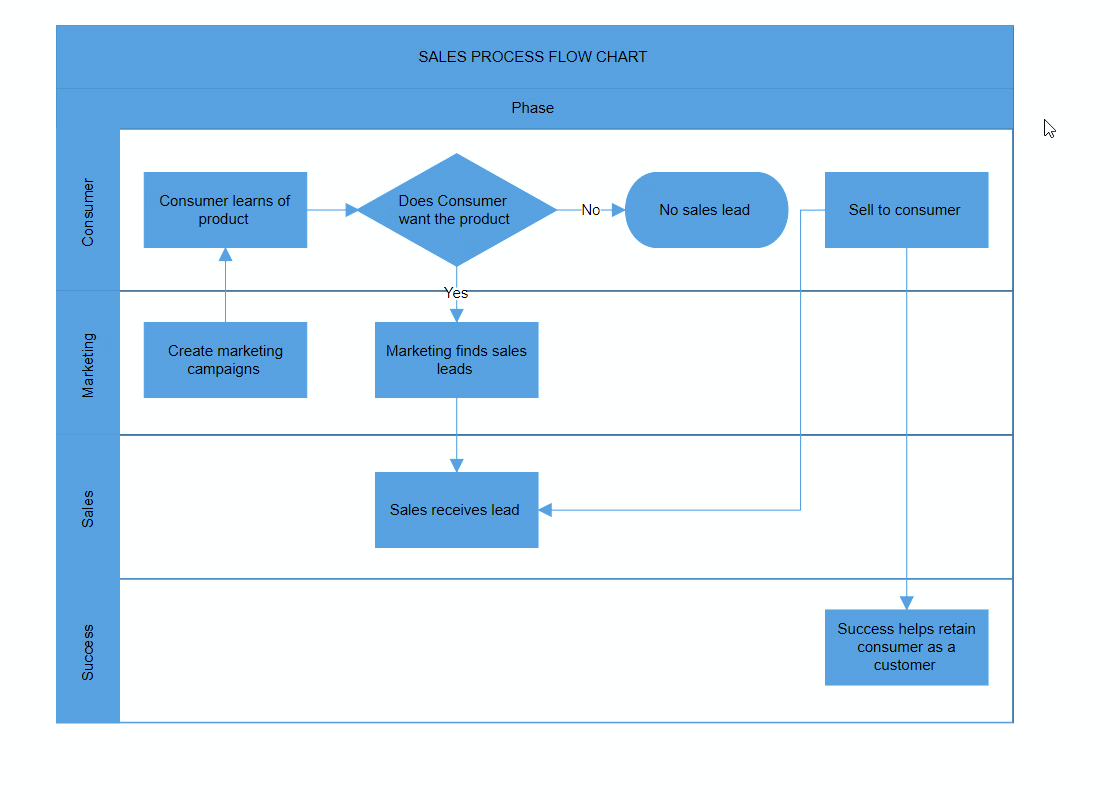Phase in Blazor Diagram Component
14 Nov 202524 minutes to read
The Phase divides each lane horizontally or vertically based on the swimlane orientation. Multiple phases can be added to a swimlane.
How to Create an Empty Phase
Create a Phase and add it to the Phases collection of the swimlane.
Note: For a horizontal swimlane, set the phase Width. For a vertical swimlane, set the phase Height.
The following code example explains how to add a phase to a swimlane.
@using Syncfusion.Blazor.Diagram
<SfDiagramComponent Height="600px" Swimlanes="@SwimlaneCollections" NodeCreating="@OnNodeCreating" />
@code
{
//Define diagram's swimlane collection.
DiagramObjectCollection<Swimlane> SwimlaneCollections = new DiagramObjectCollection<Swimlane>();
protected override void OnInitialized()
{
// A swimlane is created and stored in the swimlanes collection.
Swimlane swimlane = new Swimlane()
{
Header = new SwimlaneHeader()
{
Annotation = new ShapeAnnotation()
{
Content = "SALES PROCESS FLOW CHART"
},
Height = 50,
},
OffsetX = 400,
OffsetY = 200,
Height = 150,
Width = 450,
Phases = new DiagramObjectCollection<Phase>()
{
new Phase()
{
Width = 450,
Header = new SwimlaneHeader()
{
Annotation = new ShapeAnnotation(){Content = "Phase 1"},
Height = 30
}
}
}
};
// Add swimlane.
SwimlaneCollections.Add(swimlane);
}
private void OnNodeCreating(IDiagramObject obj)
{
if (obj is Swimlane swimlane)
{
swimlane.Header.Style = new TextStyle()
{
Fill = "#5b9bd5",
StrokeColor = "#5b9bd5"
};
foreach (Phase phase in swimlane.Phases)
{
phase.Style = new ShapeStyle() { Fill = "#5b9bd5", StrokeColor = "#5b9bd5" };
}
foreach (Lane lane in swimlane.Lanes)
{
lane.Header.Style = new TextStyle() { Fill = "#5b9bd5", StrokeColor = "#5b9bd5" };
}
}
}
}A complete working sample can be downloaded from GitHub.
.
How to Dynamically Add and Remove Phase in Swimlane
Add or remove a phase at runtime by using the Add and Remove methods of the Swimlane.Phases collection. The following code example shows how to add and remove phases at runtime.
@using Syncfusion.Blazor.Diagram
@using Syncfusion.Blazor.Buttons
<SfButton Content="Add Phase" OnClick="@AddPhase" />
<SfButton Content="Remove Phase" OnClick="@RemovePhase" />
<SfDiagramComponent Height="600px" Swimlanes="@SwimlaneCollections" NodeCreating="@OnNodeCreating" />
@code
{
//Define diagram's swimlane collection.
DiagramObjectCollection<Swimlane> SwimlaneCollections = new DiagramObjectCollection<Swimlane>();
protected override void OnInitialized()
{
// A swimlane is created and stored in the swimlanes collection.
Swimlane swimlane = new Swimlane()
{
Header = new SwimlaneHeader()
{
Annotation = new ShapeAnnotation()
{
Content = "SALES PROCESS FLOW CHART"
},
Height = 50,
},
OffsetX = 400,
OffsetY = 200,
Height = 150,
Width = 450,
Phases = new DiagramObjectCollection<Phase>()
{
new Phase()
{
Width = 450,
Header = new SwimlaneHeader()
{
Annotation = new ShapeAnnotation(){Content = "Phase 1"},
Height = 30
}
}
}
};
// Add swimlane.
SwimlaneCollections.Add(swimlane);
}
private void AddPhase()
{
Swimlane swimlane = SwimlaneCollections[0];
Phase newPhase = new Phase()
{
Width = 100,
Header = new SwimlaneHeader()
{
Annotation = new ShapeAnnotation() { Content = "Phase " + (swimlane.Phases.Count + 1) },
Height = 30
},
Style = new ShapeStyle() { Fill = "#5b9bd5", StrokeColor = "#5b9bd5" }
};
swimlane.Phases.Add(newPhase);
}
private void RemovePhase()
{
Swimlane swimlane = SwimlaneCollections[0];
if (swimlane.Phases.Count > 1)
swimlane.Phases.RemoveAt(swimlane.Phases.Count - 1);
}
private void OnNodeCreating(IDiagramObject obj)
{
if (obj is Swimlane swimlane)
{
swimlane.Header.Style = new TextStyle()
{
Fill = "#5b9bd5",
StrokeColor = "#5b9bd5"
};
foreach (Phase phase in swimlane.Phases)
{
phase.Style = new ShapeStyle() { Fill = "#5b9bd5", StrokeColor = "#5b9bd5" };
}
foreach (Lane lane in swimlane.Lanes)
{
lane.Header.Style = new TextStyle() { Fill = "#5b9bd5", StrokeColor = "#5b9bd5" };
}
}
}
}A complete working sample can be downloaded from GitHub.

How to Create and Customize the Phase Header
- The Header property describes the phase and provides appearance customization.
- Control the header size using Width and Height properties.
- Customize header appearance using Style property.
The following code example shows how to define and customize a phase header.
@using Syncfusion.Blazor.Diagram
<SfDiagramComponent Height="600px" Swimlanes="@SwimlaneCollections" NodeCreating="@OnNodeCreating"/>
@code
{
//Define diagram's swimlane collection.
DiagramObjectCollection<Swimlane> SwimlaneCollections = new DiagramObjectCollection<Swimlane>();
protected override void OnInitialized()
{
// A swimlane is created and stored in the swimlanes collection.
Swimlane swimlane = new Swimlane()
{
Header = new SwimlaneHeader()
{
Annotation = new ShapeAnnotation()
{
Content = "SALES PROCESS FLOW CHART"
},
Height = 50,
},
OffsetX = 400,
OffsetY = 200,
Height = 150,
Width = 450,
Phases = new DiagramObjectCollection<Phase>()
{
new Phase()
{
Width = 450,
Header = new SwimlaneHeader()
{
Annotation = new ShapeAnnotation(){Content = "Phase 1", Style = new TextStyle(){ Color = "White", TextDecoration = TextDecoration.Underline, Italic = true, Bold = true} },
Height = 30
},
Style = new TextStyle(){Fill = "Teal"},
}
}
};
// Add swimlane.
SwimlaneCollections.Add(swimlane);
}
private void OnNodeCreating(IDiagramObject obj)
{
if (obj is Swimlane swimlane)
{
swimlane.Header.Style = new TextStyle()
{
Fill = "#5b9bd5",
StrokeColor = "#5b9bd5"
};
foreach (Lane lane in swimlane.Lanes)
{
lane.Header.Style = new TextStyle() { Fill = "#5b9bd5", StrokeColor = "#5b9bd5" };
}
}
}
}A complete working sample can be downloaded from GitHub.
.
Phase header annotations also support templates. Define HTML content at the tag level and specify the use of a template with the UseTemplate property. To assign different templates per phase, differentiate annotations by the ID property.
The following code example explains how to define a phase header annotation template.
@using Syncfusion.Blazor.Diagram
<SfDiagramComponent Height="600px" Swimlanes="@SwimlaneCollections">
<DiagramTemplates>
<AnnotationTemplate>
@if (context is Annotation annotation)
{
if (annotation.ID == "Phase 1")
{
string ID = annotation.ID + "TemplateContent";
<div id="@ID" class="profile-card" style="width:100%;height:100%;display:flex;align-items:center; gap:10px">
<svg xmlns="http://www.w3.org/2000/svg" height="24" width="24" viewBox="0 0 24 24">
<g>
<ellipse cy="12" cx="12" ry="12" rx="12" fill="#000000" />
<path id="path1" transform="rotate(0,12,12) translate(6.06543695926666,6) scale(0.375,0.375) " fill="#FFFFFF" d="M15.827007,0C20.406003,0 24.346007,3.1960449 24.346007,9.2930298 24.346007,13.259033 22.542005,17.289001 20.180997,19.791992L20.193005,19.791992C19.287,22.627014 20.736997,23.299011 20.966,23.376038 25.997008,25.090027 31.651002,28.317993 31.651002,31.626038L31.651002,32 0,32 0,31.626038C8.034749E-08,28.414001 5.6260008,25.161011 10.421,23.376038 10.766993,23.244995 12.422999,22.317017 11.497004,19.817993 9.1220035,17.321045 7.3279971,13.275024 7.3279971,9.2930298 7.3279971,3.1960449 11.245006,0 15.827007,0z" />
</g>
</svg>
<div class="profile-name" style="font-size:12px;font-weight:bold;">Users</div>
</div>
}
}
</AnnotationTemplate>
</DiagramTemplates>
</SfDiagramComponent>
@code
{
//Define diagram's swimlane collection.
DiagramObjectCollection<Swimlane> SwimlaneCollections = new DiagramObjectCollection<Swimlane>();
protected override void OnInitialized()
{
// A swimlane is created and stored in the swimlanes collection.
Swimlane swimlane = new Swimlane()
{
Header = new SwimlaneHeader()
{
Annotation = new ShapeAnnotation()
{
Content = "SALES PROCESS FLOW CHART"
},
Height = 50,
},
OffsetX = 400,
OffsetY = 200,
Height = 150,
Width = 450,
Phases = new DiagramObjectCollection<Phase>()
{
new Phase()
{
Width = 450,
Header = new SwimlaneHeader()
{
Annotation = new ShapeAnnotation(){ ID="Phase 1",
Content = "Phase 1",
UseTemplate = true,
Height = 50,
Width = 75,
},
Height = 30,
},
Style = new TextStyle(){Fill = "Teal"},
}
}
};
// Add swimlane.
SwimlaneCollections.Add(swimlane);
}
}A complete working sample can be downloaded from GitHub.
.
How to Set the Orientation of a Phase
The Orientation property in the symbol palette defines whether a phase is displayed horizontally or vertically. This setting is particularly relevant when the phase is part of a symbol palette.
- Horizontal orientation: The phase is aligned horizontally.
- Vertical orientation: The phase is aligned vertically.
Below is an example demonstrating how to set the orientation for phases in an SfSymbolPaletteComponent:
@using Syncfusion.Blazor.Diagram
@using Syncfusion.Blazor.Diagram.SymbolPalette
<div class="control-section">
<div style="width:80%;">
<div id="palette-space" class="sb-mobile-palette" style="border: 2px solid #b200ff">
<SfSymbolPaletteComponent @ref="@symbolpalette" Height="300px" Width="200px"
Palettes="@Palettes" SymbolHeight="60" SymbolWidth="60" SymbolMargin="@SymbolMargin">
</SfSymbolPaletteComponent>
</div>
</div>
</div>
@code
{
//Reference the symbolpreview.
DiagramSize SymbolPreview;
//Define symbol margin.
SymbolMargin SymbolMargin = new SymbolMargin { Left = 15, Right = 15, Top = 15, Bottom = 15 };
SfSymbolPaletteComponent symbolpalette;
//Define palattes collection.
DiagramObjectCollection<Palette> Palettes = new DiagramObjectCollection<Palette>();
// Defines palette's swimlane-shape collection.
DiagramObjectCollection<NodeBase> SwimlaneNodes = new DiagramObjectCollection<NodeBase>();
protected override void OnInitialized()
{
InitPaletteModel();
}
private void InitPaletteModel()
{
Palettes = new DiagramObjectCollection<Palette>();
SwimlaneNodes = new DiagramObjectCollection<NodeBase>();
//create a horizontal phase.
Phase horizontalPhase = new Phase() { ID = "HorizontalPhase", Orientation = Orientation.Horizontal, Width = 80, Height = 1, Style = new ShapeStyle() { Fill = "#5b9bd5", StrokeColor = "#5b9bd5" } };
//create a vertical phase.
Phase verticalPhase = new Phase() { ID = "VerticalPhase", Orientation = Orientation.Vertical, Width = 1, Height = 80, Style = new ShapeStyle() { Fill = "#5b9bd5", StrokeColor = "#5b9bd5" } };
SwimlaneNodes = new DiagramObjectCollection<NodeBase>()
{
horizontalPhase,
verticalPhase
};
Palettes = new DiagramObjectCollection<Palette>()
{
new Palette(){Symbols =SwimlaneNodes,Title="Swimlane Shapes",ID="SwimlaneShapes" },
};
}
}You can download a complete working sample from GitHub.
.
How to Select and Resize Phase Header
-
Select an individual phase header by clicking the header twice. The first click selects the phase, and the second click selects the header.
-
Resize an individual phase header. While resizing a phase, a 20 pixels distance is maintained from the lane children.
-
When an element is resized, the SizeChanging and SizeChanged events are triggered.
The following image shows how to select and resize the phase header.

How to Edit Phase Header
Phase headers support runtime editing. Double-click the header label to enable in-place editing for that specific header.
The following image shows how to edit the phase header.

Phase Interaction
How to Select a Phase
Phase can be selected by clicking (tapping) the header of the phase.
How to Resize a Phase
- Resize the phase by using the selector.
- Click the phase header to enable phase selection.
- After resizing a phase, the lane updates its size automatically.